7 Encoding Devine Revelation: Art of the Islamic World
Learning Objectives
By the end of this chapter, you will be able to:
- Describe the early formulation and later developments of Islamic art and architecture in the Middle East, Persia, Spain, and Turkey.
- Identify and differentiate the primary types of mosque architecture and their features.
Looking Forward
The Dome of the Rock, the Taj Mahal, a Mina’i ware bowl, a silk carpet, a Qur‘an—all of these are examples of Islamic art. But what is Islamic art?
Islamic art is a modern concept created by art historians in the 19th century to facilitate categorization and study of the material first produced under the Islamic peoples that emerged from Arabia in the seventh century.
Today, the term Islamic art describes all of the arts that were produced in the lands where Islam was the dominant religion or the religion of those who ruled. Unlike the terms Christian art, Jewish art, and Buddhist art—which refer only to religious art of these faiths—the term Islamic art is not used merely to describe religious art or architecture but applies to all art forms produced in the Islamic world.
Thus, the term Islamic art refers not only to works created by Muslim artists, artisans, and architects or for Muslim patrons. It also encompasses works created by Muslim artists for patrons of any faith, including—Christians, Jews, or Hindus—and the works created by Jews, Christians, and others, living in Islamic lands, for patrons, Muslim and otherwise.
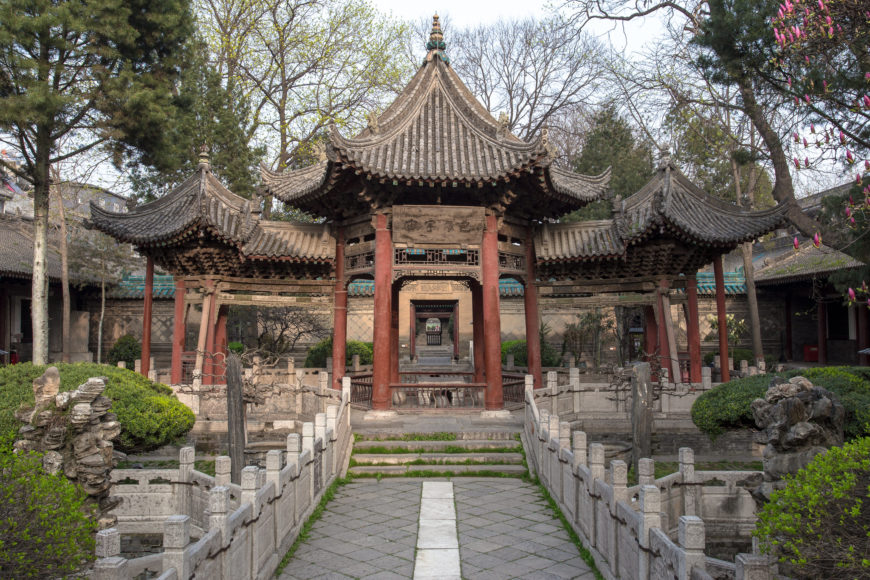
One of the most famous monuments of Islamic art is the Taj Mahal, a royal mausoleum, located in Agra, India. Hinduism is the majority religion in India; however, because Muslim rulers, most famously the Mughals, dominated large areas of modern-day India for centuries, India has a vast range of Islamic art and architecture. The Great Mosque of Xian, China is one of the oldest and best-preserved mosques in China. First constructed in 742 CE, the mosque’s current form dates to the 15th century CE and follows the plan and architecture of a contemporary Buddhist temple. In fact, much Islamic art and architecture was—and still is—created through a synthesis of local traditions and more global ideas.
Art of the Islamic World
In some ways, Islamic art is a bit like referring to the Italian Renaissance. During the Renaissance, there was no unified Italy; it was a land of independent city-states. No one would have thought of themselves as an Italian, or of the art they produced as Italian. Rather, a person would have self-identified as a Roman, a Florentine, or a Venetian. Each city developed a highly local, remarkable style. At the same time, there are certain underlying themes or similarities that unify the art and architecture of these cities and allow scholars to speak of an Italian Renaissance.
Similarly, there are themes and types of objects that link the arts of the Islamic world together. Calligraphy is a very important art form in the Islamic world. The Qur’an, written in elegant scripts, represents Allah’s—or God’s—divine word, which Muhammad received directly from Allah during his visions. Quranic verses, executed in calligraphy, are found on many different forms of art and architecture. Likewise, poetry can be found on everything from ceramic bowls to the walls of houses. Calligraphy’s omnipresence underscores the value that is placed on language, specifically Arabic.
Muhammad and the Origins of Islam
Islam, Judaism, and Christianity are three of the world’s great monotheistic faiths. They share many of the same holy sites, such as Jerusalem, and prophets, such as Abraham. Collectively, scholars refer to these three religions as the Abrahamic faiths, since Abraham and his family played vital roles in the formation of these religions.
Islam was founded by Muhammad (c. 570–632 C.E.), a merchant from the city of Mecca, now in modern-day Saudi Arabia. Muhammad was born in 570 C.E. in Mecca. Around 610 C.E., Muhammad had his first religious experience, where he was instructed to recite by the Angel Gabriel. After a period of introspection and self-doubt, Muhammad accepted his role as God’s prophet and began to preach word of the one God, or Allah in Arabic.
Muhammad’s divine recitations form the Qur’an, the holy book of Islam. During one of his many visions, in 621 C.E., Muhammad was taken on the famous Night Journey by the Angel Gabriel, travelling from Mecca to the farthest mosque in Jerusalem, from where he ascended into heaven. The site of his ascension is believed to be the stone around which the Dome of the Rock was built. Eventually in 622, Muhammad and his followers fled Mecca for the city of Yathrib, which is known as Medina today, where his community was welcomed.
Between 625–630 C.E., there were a series of battles fought between the Meccans and Muhammad and the new Muslim community. Eventually, Muhammad was victorious and reentered Mecca in 630.
One of Muhammad’s first actions was to purge the Kaaba of all of its idols (before this, the Kaaba was a major site of pilgrimage for the polytheistic religious traditions of the Arabian Peninsula and contained numerous idols of pagan gods). The Kaaba is believed to have been built by Abraham and his son, Ishmael. The Arabs claim descent from Ishmael, the son of Abraham and Hagar. The Kaaba then became the most important center for pilgrimage in Islam.
In 632, Muhammad died in Medina. Muslims believe that he was the final in a line of prophets, which included Moses, Abraham, and Jesus.
Geometric and vegetative motifs are very popular throughout the lands where Islam was once or still is a major religion and cultural force, appearing in the private palaces of buildings such as the Alhambra, in Spain, as well as in the detailed metal work of Safavid Iran. Likewise, certain building types appear throughout the Islamic world: mosques with their minarets, mausolea, gardens, and madrasas—religious schools—are all common. However, their forms vary greatly.
One of the most common misconceptions about the art of the Islamic world is that it is aniconic; that is, the art does not contain representations of humans or animals. Early examples of religious art and architecture, such as the Dome of the Rock and the Aqsa Mosque—both in Jerusalem)—and the Great Mosque of Damascus—built under the Umayyad rulers—did not include human figures and animals. However, the private residences of sovereigns, such as Qasr ‘Amra and Khirbat Mafjar, were filled with vast figurative paintings, mosaics, and sculpture.
The Kaaba, a pre-Islamic structure

The Kaaba, meaning ‘cube’ in Arabic, is a square building elegantly draped in a silk and cotton veil. Located in Mecca, Saudi Arabia, it is the holiest shrine in Islam. In Islam, Muslims pray five times a day and after 624 CE, these prayers were directed towards Mecca and the Kaaba rather than Jerusalem; this direction—or qibla in Arabic—is marked in all mosques and enables the faithful to know in which direction they should pray.
All Muslims aspire to undertake the hajj, or the annual pilgrimage, to the Kaaba once in their lives if they are able. Prayer five times a day and the hajj are two of the five pillars of Islam, the most fundamental principles of the faith. Upon arriving in Mecca, pilgrims gather in the courtyard of the Masjid al-Haram around the Kaaba. They then circumambulate the Kaaba.
The Five Pillars of Islam
Almost as soon as the Arab armies of Islam conquered new lands, they began erecting mosques and palaces, as well as commissioning other works of art as expressions of their faith and culture. Connected to this, many aspects of religious practice in Islam also emerged and were codified. The religious practice of Islam, which literally means to submit to God, is based on tenets that are known as the Five Pillars (arkan), to which all members of the Islamic community (umma) should adhere.
- The profession of faith (shahada): the most fundamental expression of Islamic beliefs. It simply states that “There is no God but God and Muhammad is his prophet.” It underscores the monotheistic nature of Islam. It is an extremely popular phrase in Arabic calligraphy and appears in numerous manuscripts and religious buildings.
- Daily prayers (salat): Muslims are expected to pray five times a day. Muslims can pray anywhere; however, they are meant to pray towards Mecca. The faithful are meant to pray by bowing several times while standing and then kneel and touch the ground or prayer mat with their foreheads, as a symbol of their reverence and submission to Allah. On Friday, many Muslims attend the mosque near mid-day to pray and to listen to a sermon (khutba).
- Almsgiving (zakat): The giving of alms is the third pillar. Although not defined in the Qu’ran, Muslims believe that they are meant to share their wealth with those less fortunate in their community of believers.
- Fasting during Ramadan (saum): During the holy month of Ramadan (the ninth month in the Islamic calendar), Muslims are expected to fast from dawn to dusk. While there are exceptions made for the sick, elderly, and pregnant, all are expected to refrain from eating and drinking during daylight hours.
- Pilgrimage to Mecca (hajj): All Muslims, who are able, are required to make the pilgrimage to Mecca and the surrounding holy sites at least once in their lives. Pilgrimage focuses on visiting the Kaaba and walking around it seven times. Pilgrimage occurs in the twelfth month of the Islamic Calendar.

The Kaaba was a sanctuary in pre-Islamic times. Prior to Islam, the Kaaba was a holy site for the various Bedouin tribes throughout the Arabian Peninsula. Once every lunar year, Bedouin people would make a pilgrimage to Mecca. Setting aside any tribal feuds, they would worship their gods, whose sacred statues resided in the Kaaba, and trade with each other in the city. The Quraysh tribe, who ruled Mecca, rebuilt the pre-Islamic Kaaba in c. 608 CE with alternating courses of masonry and wood. A door was raised above ground level to protect the shrine from intruders and flood waters.
The Kaaba has been modified extensively throughout its history. The area around the Kaaba was expanded in order to accommodate the growing number of pilgrims by the second caliph, ‘Umar, who ruled 634-44 CE. The Caliph ‘Uthman, who ruled 644-56 CE, built the colonnades around the open plaza where the Kaaba stands and incorporated other important monuments into the sanctuary.
During the civil war between the caliph Ibn Zubayr, who controlled Mecca, and the rival Umayyads the Kaaba was set on fire in 683 CE. Reportedly, the Black Stone[1] broke into three pieces and Ibn Zubayr reassembled it with silver. He rebuilt the Kaaba in wood and stone and also paved the space around the Kaaba. After regaining control of Mecca, Abd al-Malik restored the part of the building that Muhammad is thought to have designed. None of these renovations can be confirmed through study of the building or archaeological evidence; these changes are only outlined in later literary sources.
Reportedly under the Umayyad caliph al-Walid, who ruled 705-15 CE, the mosque that encloses the Kaaba was decorated with mosaics like those of the Dome of the Rock and the Great Mosque of Damascus. By the seventh century, the Kaaba was covered with a kiswa, a black cloth that is replaced annually during the hajj.
Under the early Abbasid Caliphs, who ruled from 750-1250 CE, the mosque around the Kaaba was expanded and modified several times. According to travel writers, such as the Ibn Jubayr who saw the Kaaba in 1183 CE, it retained the eighth century Abbasid form for several centuries. From 1269-1517 CE, the Mamluks of Egypt controlled the Hijaz, the highlands in western Arabia where Mecca is located. Sultan Qaitbay, who ruled 1468-96 CE, built a madrasa—a religious school—against one side of the mosque. Under the Ottoman sultans, Süleyman I, who ruled 1520-1566 CE, and Selim II, who ruled 1566-74 CE, the complex was heavily renovated. In 1631 CE, the Kaaba and the surrounding mosque were entirely rebuilt after floods had demolished them in the previous year. This mosque, which is what exists today, is composed of a large open space with colonnades on four sides and with seven minarets, the largest number of any mosque in the world. At the center of this large plaza sits the Kaaba, as well as many other holy buildings and monuments.
The last major modifications were carried out in the 1950s by the government of Saudi Arabia to accommodate the increasingly large number of pilgrims who come on the hajj. Today the mosque covers almost 40 acres.

Today, the Kaaba is a cubical structure, unlike almost any other religious structure. It is fifteen meters tall and ten and a half meters on each side; its corners roughly align with the cardinal directions. The door of the Kaaba is now made of solid gold; it was added in 1982. The kiswa—the large cloth that covers the Kaaba—used to be sent from Egypt with the hajj caravan but today is made in Saudi Arabia. Until the advent of modern transportation, all pilgrims undertook the often-dangerous hajj, or pilgrimage, to Mecca in a large caravan across the desert, leaving from Damascus, Cairo, and other major cities in Arabia, Yemen, or Iraq.
The numerous changes to the Kaaba and its associated mosque serve as good reminder of how often buildings, even sacred ones, are renovated and remodeled either due to damage or to the changing needs of the community.
Art in Transition: Dome of the Rock
The Dome of the Rock is a building of extraordinary beauty, solidity, elegance, and singularity of shape… Both outside and inside, the decoration is so magnificent and the workmanship so surpassing as to defy description. The greater part is covered with gold so that the eyes of one who gazes on its beauties are dazzled by its brilliance, now glowing like a mass of light, now flashing like lightning.
Ibn Battuta (14th century travel writer)
The first years following the death of Muhammad were, of course, formative for the religion and its artwork. The immediate needs of the religion included places to worship, so many of the first artistic projects included ornamented mosques where the faithful could gather.
Because Islam was still a very new religion, it had no artistic vocabulary of its own, and its earliest work was heavily influenced by older styles in the region. Chief among these sources were the Coptic tradition of present-day Egypt and Syria, with its scrolling vines and geometric motifs, Sassanian metalwork and crafts from what is now Iraq with their rhythmic, sometimes abstracted qualities, and naturalistic Byzantine mosaics depicting animals and plants.
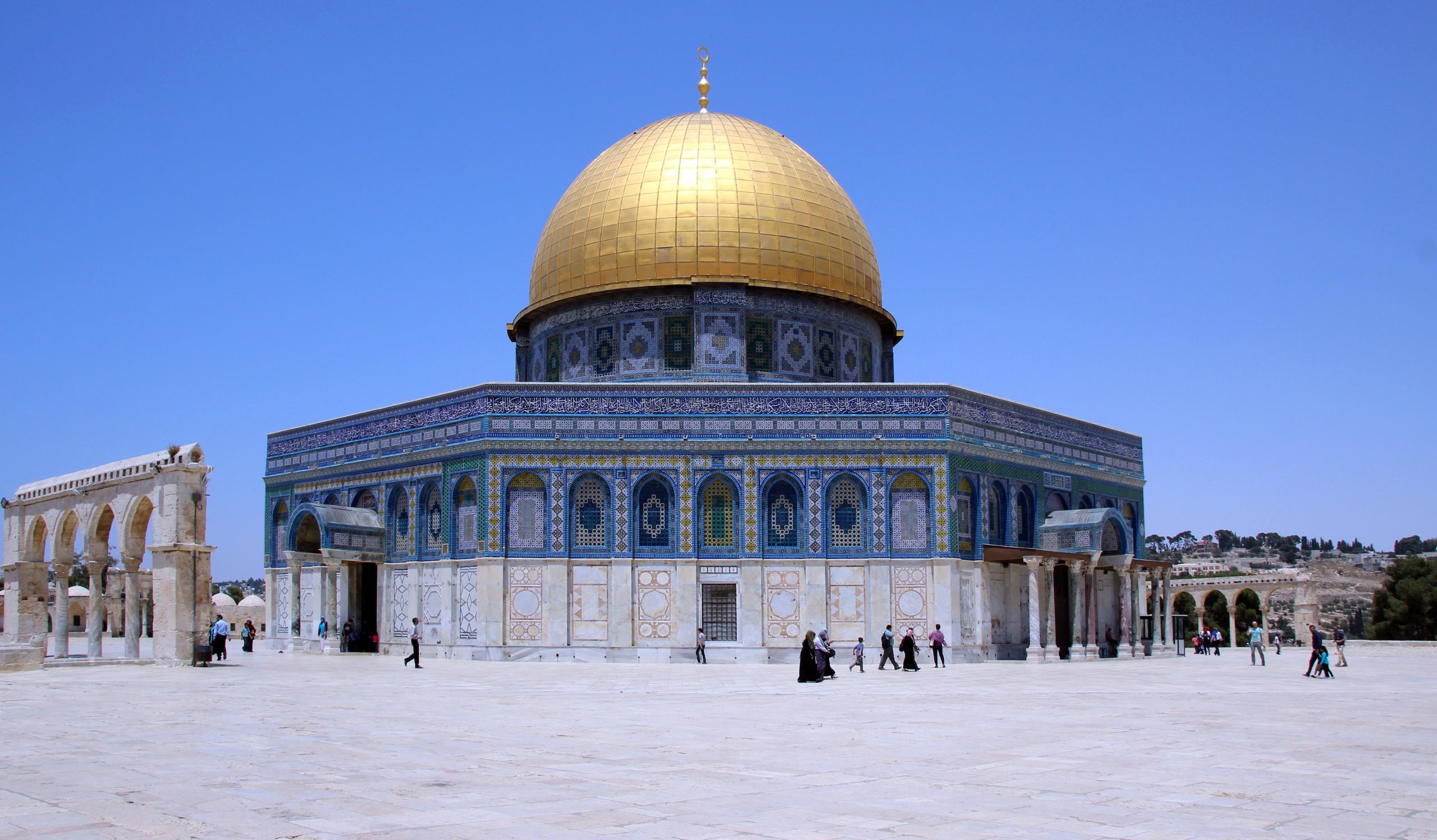
These elements can be seen in the earliest significant work from the Umayyad period[2], the most important of which is the Dome of the Rock in Jerusalem. This stunning monument incorporates Coptic, Sassanian, and Byzantine elements in its decorative program and remains a masterpiece of Islamic architecture to this day.
The Dome of the Rock is one of the earliest surviving buildings from the Islamic world. This remarkable building is not a mosque, as is commonly assumed and scholars still debate its original function and meaning.

Between the death of the prophet Muhammad in 632 and 691/2, when the Dome of the Rock was completed, there was intermittent warfare in Arabia and Holy Land around Jerusalem. The first Arab armies who emerged from the Arabian Peninsula were focused on conquering and establishing an empire—not building.
Thus, the Dome of the Rock was one of the first Islamic buildings ever constructed. It was built between 685 and 691/2 by Abd al-Malik, probably the most important Umayyad caliph, as a religious focal point for his supporters, while he was fighting a civil war against Ibn Zubayr. When Abd al-Malik began construction on the Dome of the Rock, he did not have control of the Kaaba, the holiest shrine in Islam located in Mecca.
The Dome is located on the Haram al-Sharif, an enormous open-air platform that now houses Al-Aqsa mosque and several other religious buildings. Few places are as holy for Christians, Jews and Muslims as the Haram al-Sharif. It is the Temple Mount, the site of the Jewish second temple, which the Roman Emperor Titus destroyed in 70 C.E. while subduing the Jewish revolt; a Roman temple was later built on the site. The Temple Mount was abandoned in Late Antiquity.
At the center of the Dome of the Rock sits a large rock, which is believed to be the location where Abraham was prepared to sacrifice his son Ismail (Isaac in the Judeo/Christian tradition). Today, Muslims believe that the Rock commemorates the night journey of Muhammad. One night the Angel Gabriel came to Muhammad while he slept near the Kaaba in Mecca and took him to al-Masjid al-Aqsa (the farthest mosque) in Jerusalem. From the Rock, Muhammad journeyed to heaven, where he met other prophets, such as Moses and Christ, witnessed paradise and hell and finally saw God enthroned and circumambulated by angels.
The Rock is enclosed by two ambulatories (in this case the aisles that circle the rock) and an octagonal exterior wall. The central colonnade (row of columns) was composed of four piers and twelve columns supporting a rounded drum that transitions into the two-layered dome more than 20 meters in diameter.

The colonnades are clad in marble on their lower registers, and their upper registers are adorned with exceptional mosaics. The ethereal interior atmosphere is a result of light that pours in from grilled windows located in the drum and exterior walls. Golden mosaics depicting jewels shimmer in this glittering light. Byzantine and Sassanian crowns in the midst of vegetal motifs are also visible.
The Byzantine Empire stood to the North and to the West of the new Islamic Empire until 1453, when its capital, Constantinople, fell to the Ottoman Turks. To the East, the old Sasanian Empire of Persia imploded under pressure from the Arabs, but nevertheless provided winged crown motifs that can be found in the Dome of the Rock.
Wall and ceiling mosaics became very popular in Late Antiquity and adorn many Byzantine churches, including San Vitale in Ravenna and Hagia Sophia in Constantinople. Thus, the use of mosaics reflects an artistic tie to the world of Late Antiquity.
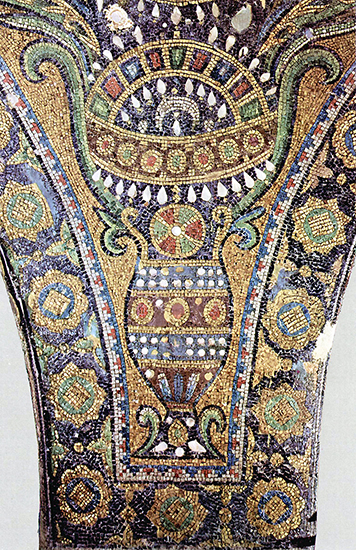
The mosaics in the Dome of the Rock contain no human figures or animals. While Islam does not prohibit the use of figurative art per se, it seems that in religious buildings, this proscription was upheld. Instead, we see vegetative scrolls and motifs (arabesques), as well as vessels and winged crowns, which were worn by Sasanian kings. Thus, the iconography of the Dome of the Rock also includes the other major pre-Islamic civilization of the region, the Sasanian Empire, which the Arab armies had defeated.
The building enclosing the Rock also seems to take its form from the imperial mausolea (the burial places) of Roman emperors, such as Augustus or Hadrian. Its circular form and Dome also reference the Church of the Holy Sepulcher in Jerusalem, built to enclose the tomb of Christ. The Church of the Holy Sepulcher and the Dome of the Rock have domes that are almost identical in size; this suggests that the elevated position of the Dome of the Rock and the comparable size of its dome was a way that Muslims in the late 8th century proclaimed the superiority of their newly formed faith over Christians.
The Dome of the Rock also contains an inscription, 240 meters long, that includes some of the earliest surviving examples of verses from the Qur’an – in an architectural context or otherwise. The bismillah[3] and the shahada are also included in the inscription. The inscription also refers to Mary and Christ and proclaim that Christ was not divine but a prophet. Thus, the inscription also proclaims some of the core values of the newly formed religion of Islam.
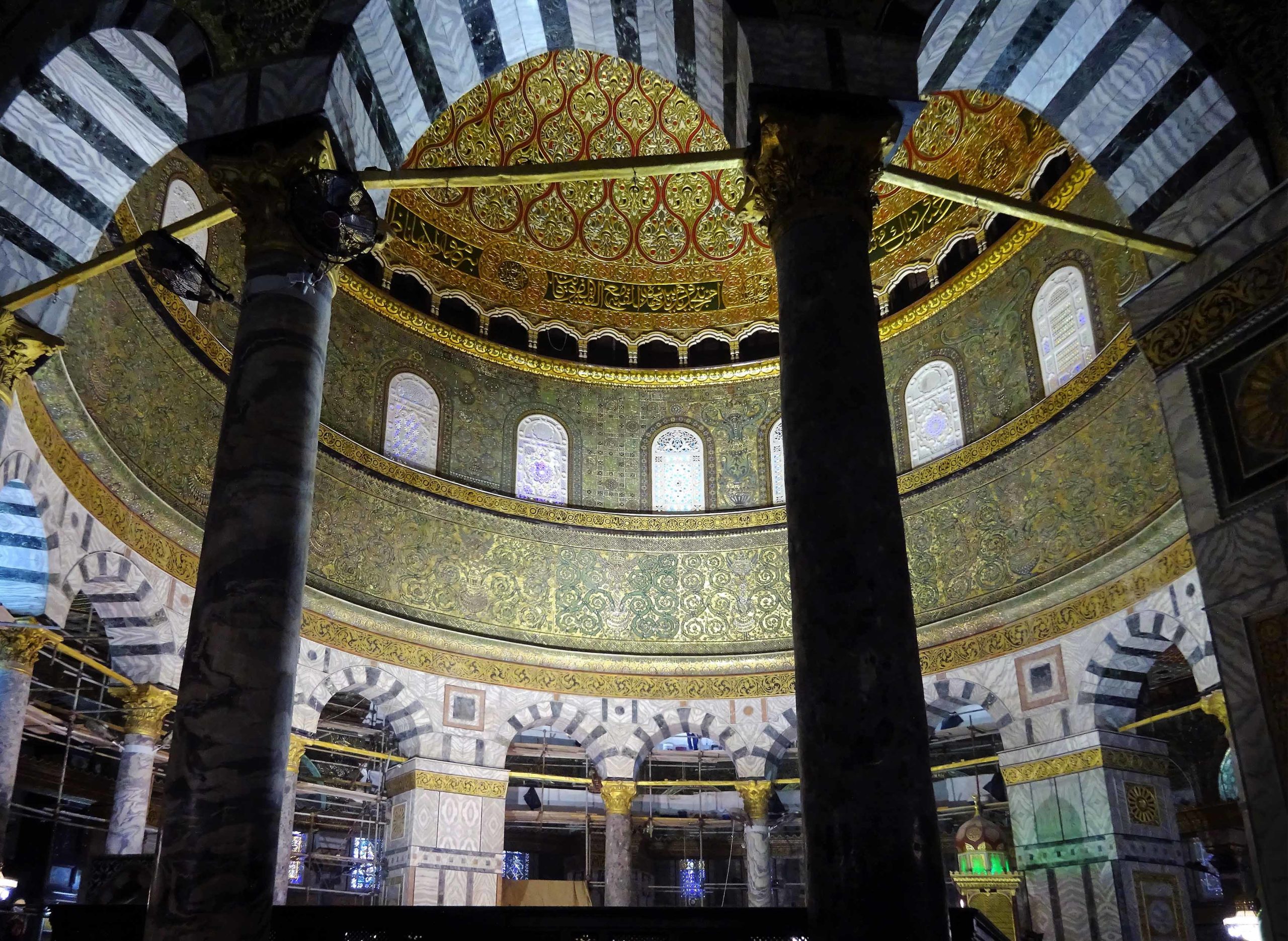
The Islamic Mosque
Remarkably, just one generation after the religion’s inception, Islamic civilization had produced a magnificent, if singular, monument. While the Dome of the Rock is considered an influential work, it bears little resemblance to the multitude of mosques created throughout the rest of the caliphate.

From Indonesia to the United Kingdom, the mosque in its many forms is the quintessential Islamic building. The mosque, masjid in Arabic, is the Muslim gathering place for prayer. Masjid simply means “place of prostration.” Though most of the five daily prayers prescribed in Islam can take place anywhere, all men are required to gather together at the mosque for the Friday noon prayer.
Mosques are also used throughout the week for prayer, study, or simply as a place for rest and reflection. The main mosque of a city, used for the Friday communal prayer, is called a jami masjid, literally meaning “Friday mosque,” but it is also sometimes called a congregational mosque in English. The style, layout, and decoration of a mosque can tell us a lot about Islam in general, but also about the period and region in which the mosque was constructed.
Common Features of the Islamic Mosque
The architecture of a mosque is shaped most strongly by the regional traditions of the time and place where it was built. As a result, style, layout, and decoration can vary greatly. Nevertheless, because of the common function of the mosque as a place of congregational prayer, certain architectural features appear in mosques all over the world.
Sahn (courtyard)
The most fundamental necessity of congregational mosque architecture is that it be able to hold the entire male population of a city or town (women are welcome to attend Friday prayers, but not required to do so). To that end, congregational mosques must have a large prayer hall. In many mosques this is adjoined to an open courtyard, called a sahn. Within the courtyard one often finds a fountain, its waters both a welcome respite in hot lands, and important for the ablutions done before prayer.
Mihrab (niche)

Another essential element of a mosque’s architecture is a mihrab—a niche in the wall that indicates the direction of Mecca, towards which all Muslims pray. Mecca is the city in which the Prophet Muhammad was born, and the home of the most important Islamic site, the Kaaba. The direction of Mecca is called the qibla, and so the wall in which the mihrab is set is called the qibla wall. No matter where a mosque is, its mihrab indicates the direction of Mecca (or as near that direction as science and geography were able to place it). Therefore, a mihrab in India will be to the west, while a one in Egypt will be to the east. A mihrab is usually a relatively shallow niche, as in the example from Egypt, above.
Ilkhanid Mihrab
Minaret (tower)
One of the most visible aspects of mosque architecture is the minaret, a tower adjacent or attached to a mosque, from which the call to prayer is announced. Minarets take many different forms—from the famous spiral minaret of Samarra, to the tall, pencil minarets of Ottoman Turkey. Not solely functional in nature, the minaret serves as a powerful visual reminder of the presence of Islam.
Qubba (dome)
Most mosques also feature one or more domes, called qubba in Arabic. While not a ritual requirement like the mihrab, a dome does possess significance within the mosque—as a symbolic representation of the vault of heaven. The interior decoration of a dome often emphasizes this symbolism, using intricate geometric, stellate, or vegetal motifs to create breathtaking patterns meant to awe and inspire. Some mosque types incorporate multiple domes into their architecture, while others only feature one. In mosques with only a single dome, it is invariably found surmounting the qibla wall, the holiest section of the mosque.
Furnishings
There are other decorative elements common to most mosques. For instance, a large calligraphic frieze or a cartouche with a prominent inscription often appears above the mihrab. In most cases the calligraphic inscriptions are quotations from the Qur’an, and often include the date of the building’s dedication and the name of the patron.
Another important feature of mosque decoration are hanging lamps. Light is an essential feature for mosques, since the first and last daily prayers occur before the sun rises and after the sun sets. Before electricity, mosques were illuminated with oil lamps. Hundreds of such lamps hung inside a mosque would create a glittering spectacle, with soft light emanating from each, highlighting the calligraphy and other decorations on the lamps’ surfaces. Although not a permanent part of a mosque building, lamps, along with other furnishings like carpets, formed a significant—though ephemeral—aspect of mosque architecture.
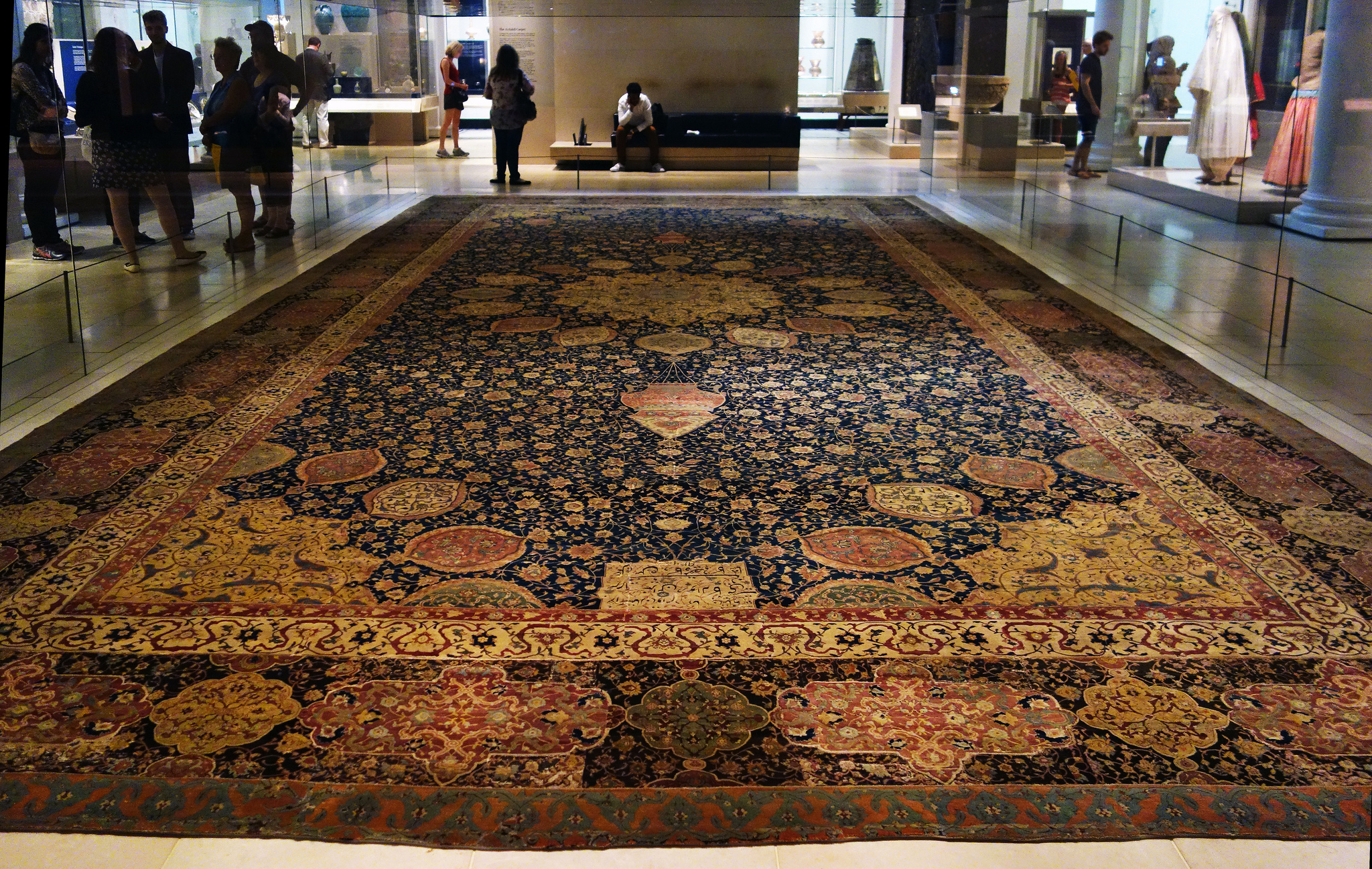
Carpets are among the most fundamental of Islamic arts. Portable, typically made of silk and wools, carpets were traded and sold across the Islamic lands and beyond its boundaries to Europe and China. Those from Iran were highly prized. Carpets decorated the floors of mosques, shrines and homes, but they could also be hung on walls of houses to preserve warmth in the winter.
Common Types of Mosque Architecture
The home of the Prophet Muhammad is considered the first mosque. His house, in Medina in modern-day Saudi Arabia, was a typical 7th-century Arabian style house, with a large courtyard surrounded by long rooms supported by columns. Since the 7th century, mosques have been built around the globe. While there are many different types of mosque architecture, three basic forms can be defined:
The Hypostyle Mosque

It makes sense that the first place of worship for Muslims, the house of the Prophet Muhammad, inspired the earliest type of mosque – the hypostyle mosque. This type spread widely throughout Islamic lands.
The Great Mosque of Kairouan, Tunisia, is an archetypal example of the hypostyle mosque. The mosque was built in the ninth century by Ziyadat Allah, the third ruler of the Aghlabid dynasty, an offshoot of the Abbasid Empire[4]. It is a large, rectangular stone mosque with a hypostyle (supported by columns) hall and a large inner sahn (courtyard). The three-tiered minaret is in a style known as the Syrian bell-tower and may have originally been based on the form of ancient Roman lighthouses. The interior of the mosque features the forest of columns that has come to define the hypostyle type.

The mosque was built on a former Byzantine site, and the architects repurposed older materials, such as the columns—a decision that was both practical and a powerful assertion of the Islamic conquest of Byzantine lands. Many early mosques like this one made use of older architectural materials (spolia), in a similarly symbolic way.
On right hand side of mosque’s mihrab is the maqsura, a special area reserved for the ruler found in some, but not all, mosques. This mosque’s maqsura is the earliest extant example, and its minbar (pulpit) is the earliest dated minbar known to scholars. Both are carved from teak wood that was imported from Southeast Asia. This prized wood was shipped from Thailand to Baghdad where it was carved, then carried on camel back from Iraq to Tunisia, in a remarkable display of medieval global commerce.

The hypostyle plan was used widely in Islamic lands prior to the introduction of the four-iwan plan in the twelfth century. The hypostyle plan’s characteristic forest of columns was used in different mosques to great effect. One of the most famous examples is the Great Mosque of Cordoba, which uses bi-color, two-tier arches that emphasize the almost dizzying optical effect of the hypostyle hall.
The Great Mosque of Cordoba

The Great Mosque of Cordoba is a prime example of the Muslim world’s ability to brilliantly develop architectural styles based on pre-existing regional traditions. Here is an extraordinary combination of the familiar and the innovative, a formal stylistic vocabulary that can be recognized as “Islamic” even today.
Known locally as Mezquita-Catedral, the Great Mosque of Cordoba is one of the oldest structures still standing from the time Muslims ruled Al-Andalus (Muslim Iberia including most of Spain, Portugal, and a small section of Southern France) in the late 8th century.
The buildings on this site are as complex as the extraordinarily rich history they illustrate. Historians believe that there had first been a temple to the Roman god, Janus, on this site. The temple was converted into a church by invading Visigoths who seized Cordoba in 572. Next, the church was converted into a mosque and then completely rebuilt by the descendants of the exiled Umayyads—the first Islamic dynasty who had originally ruled from their capital Damascus (in present-day Syria) from 661 until 750.
Following the overthrow of his family (the Umayyads) in Damascus by the incoming Abbasids, Prince Abd al-Rahman I escaped to southern Spain. Once there, he established control over almost all of the Iberian Peninsula and attempted to recreate the grandeur of Damascus in his new capital, Cordoba. He sponsored elaborate building programs, promoted agriculture, and even imported fruit trees and other plants from his former home. Orange trees still stand in the courtyard of the Mosque of Cordoba, a beautiful, if bittersweet reminder of the Umayyad exile.
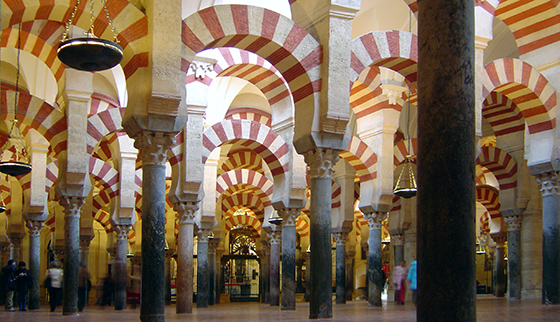
The building itself was expanded over two hundred years. It is comprised of a large hypostyle prayer hall, a courtyard with a fountain in the middle, an orange grove, a covered walkway circling the courtyard, and a minaret that is now encased in a squared, tapered bell tower. The expansive prayer hall seems magnified by its repeated geometry and is built with recycled ancient Roman columns from which sprout a striking combination of two-tiered, symmetrical arches, formed of stone and red brick.
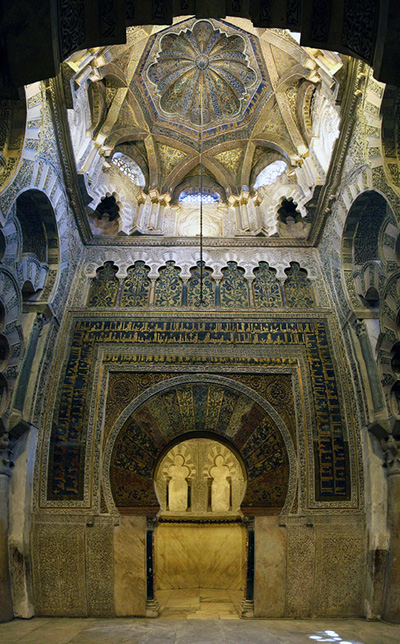
The focal point in the prayer hall is the famous horseshoe arched mihrab or prayer niche. The mihrab in the Great Mosque of Cordoba is framed by an exquisitely decorated arch behind which is an unusually large space, the size of a small room. Gold tesserae (singular: tessera; small blocks of stone, tile, glass, or other material used in the construction of a mosaic) create a dazzling combination of dark blues, reddish browns, yellows and golds that form intricate calligraphic bands and vegetal motifs that adorn the arch.
The horseshoe-style arch was common in the architecture of the Visigoths, the people that ruled this area after the Roman empire collapsed and before the Umayyads arrived. The horseshoe arch eventually spread across North Africa from Morocco to Egypt and is an easily identified characteristic of Western Islamic architecture (though there are some early examples in the East as well).
Above the mihrab, is an equally dazzling dome. It is built of crisscrossing ribs that create pointed arches all lavishly covered with gold mosaic in a radial pattern. This astonishing building technique anticipates later Gothic rib vaulting, though on a more modest scale.
The Four-Iwan Mosque
Just as the hypostyle hall defined much of mosque architecture of the early Islamic period; the 11th century shows the emergence of new form: the four-iwan mosque. An iwan is a vaulted space that opens on one side to a courtyard, developed in pre-Islamic Iran where it was used in monumental and imperial architecture. Though it originated in Iran, the four-iwan plan would become the new plan for mosques all over the Islamic word, used widely from India to Cairo and replacing the hypostyle mosque in many places.
The Great Mosque of Isfahan reflects this broader development. The mosque began its life as a hypostyle mosque but was modified by the Seljuqs of Iran after their conquest of the city of Isfahan in the 11th century. Like a hypostyle mosque, the layout is arranged around a large open courtyard. However, in the four-iwan mosque, each wall of the courtyard is punctuated with a monumental, vaulted hall, the iwan.
The Great Mosque of Isfahan
Most cities with sizable Muslim populations possess a primary congregational mosque. Diverse in design and dimensions, they can illustrate the style of the period or geographic region, the choices of the patron, and the expertise of the architect. Congregational mosques are often expanded in conjunction with the growth and needs of the umma, or Muslim community; however, it is uncommon for such expansion and modification to continue over a span of a thousand years. The Great Mosque of Isfahan in Iran is unique in this regard and thus enjoys a special place in the history of Islamic architecture. Its present configuration is the sum of building and decorating activities carried out from the 8th through the 20th centuries. It is an architectural documentary, visually embodying the political exigencies and aesthetic tastes of the great Islamic empires of Persia.

Another distinctive aspect of the mosque is its urban integration. Positioned at the center of the old city, the mosque shares walls with other buildings abutting its perimeter. Due to its immense size and its numerous entrances (all except one inaccessible now), it formed a pedestrian hub, connecting the arterial network of paths crisscrossing the city. Far from being an insular sacred monument, the mosque facilitated public mobility and commercial activity thus transcending its principal function as a place for prayer alone.

Given its sprawling expanse, one can imagine how difficult it would be to locate the correct direction for prayer. The qibla iwan on the southern side of the courtyard solves this conundrum. It is the only one flanked by two cylindrical minarets and also serves as the entrance to one of two large, domed chambers within the mosque. Similar to its three counterparts, this iwan sports colorful tile decoration and muqarnas, traditional Islamic cusped niches. The domed interior was reserved for the use of the ruler and gives access to the main mihrab of the mosque.
The Centrally-Planned Mosque

While the four-iwan plan was used for mosques across the Islamic world, the Ottoman Empire was one of the few places in the central Islamic lands where the four-iwan mosque plan did not dominate. The Ottoman Empire was founded in 1299, but it did not become a major force until the 15th century when Mehmed II conquered Constantinople, the capital of the late Roman (Byzantine) Empire since the 4th century. Renamed Istanbul, the city straddles the European and Asian continents, and, having been a Christian capital for over a thousand years, had a wholly different cultural and architectural heritage than Iran. The Ottoman architects were strongly influenced by Hagia Sophia in Istanbul, the greatest of all Byzantine churches and one that features a monumental central dome high over its large nave.
Hagia Sophia as a Mosque
- a rock set into the eastern corner of the Kaaba, the ancient building in the center of the Grand Mosque in Mecca, Saudi Arabia. It is revered by Muslims as an Islamic relic which, according to Muslim tradition, dates back to the time of Adam and Eve. ↵
- the second of the four major caliphates established after the death of Muhammad. ↵
- “in the name of God, the merciful and compassionate”: the phrase that starts each verse of the Qur’an. ↵
- the third caliphate to succeed the Islamic prophet Muhammad. It was founded by a dynasty descended from the prophet's uncle, Abbas ibn Abdul-Muttalib, from whom the dynasty takes its name. ↵
The Mughal Empire was a Muslim empire that controlled much of the Indian subcontinent from 1526 to 1858, ruling a largely Hindu population.
a visual art related to writing. It is the design and execution of lettering with a pen, ink brush, or other writing instrument.
the absence of artistic representations of either the natural and supernatural worlds, or certain figures in religion
the act of moving around a sacred object or idol. Circumambulation of temples or deity images is an integral part of Hindu and Buddhist devotional practice. It is also present in other religions, including Christianity, Judaism, and Islam
the chief Muslim civil and religious ruler, regarded as the successor of Muhammad.
Arabic: masjid; a place of prayer for Muslims. Mosques are usually covered buildings, but can be any place where prayers are performed, including outdoor courtyards.
Christian ethnoreligious group indigenous to North Africa who have primarily inhabited the area of modern Egypt and Sudan since antiquity.
a place for walking, especially an aisle around the apse or a cloister in a church or monastery.
an ornament or style that employs flower, foliage, or fruit and sometimes animal and figural outlines to produce an intricate pattern of interlaced lines.
a ceremonial act of washing parts of the body or sacred containers. Wudu is the Islamic procedure for cleansing parts of the body; the 4 Mandatory acts of Wudu consists of washing the face, arms, then wiping the head and the feet with water.
In Christianity, both baptism and footwashing are forms of ablution
arranged in a radiating pattern like that of a star.
